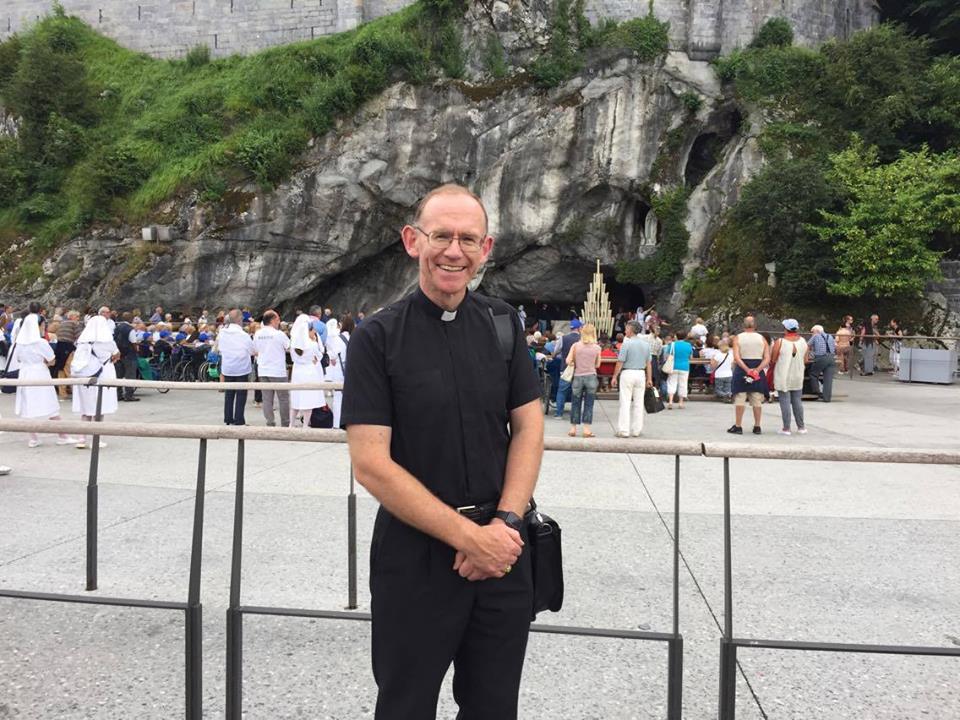The 61st annual Killaloe diocesan pilgrimage to Lourdes takes place this week, with more than 500 pilgrims making the journey. In his homily at the opening Mass of the pilgrimage, Bishop Monahan spoke on the pilgrim symbol of the scallop shell, and ‘letting go to let God’.
Bishop Monahan began, ‘I have with me what is probably the most famous symbol or badge of pilgrimage, the scallop shell worn on the back pack of pilgrims as they walk the 800 kilometres towards Santiago de Compostela. This little shell was harvested from the sea off Inisbarra, a tiny Island out from Lettermore, Co Galway, where my Grandmother hailed from. It survived the course from the French Pyrenees along the Camino to Compostela, on to Finisterre and back home and onwards here to Our Lady’s Shrine at Lourdes. This shell, which is an outside layer, reminds us that there was once something inside as well. It represents all our inward journeys here today as pilgrims to pray, to get closer to God, to make real some of that great love mentioned in the Gospel, whether that be from the far end of Loop Head or as far east as Kinnity. Today we hope that the shell of our hearts will be filled and over-flow abundantly with the substance, the stuff, the reward of pilgrimage.’
He continued, ‘Pilgrimage is about letting go. Letting go of the things that can enslave us in our normal routine. The heart of the pilgrim journey is trusting in providence and leaving anxiety behind. Tagore said, one is a “fool to try to carry thyself upon thy own shoulders”. This day, as pilgrims in Lourdes we bare our souls before the Lord and realise that He is there for us with open arms and we actually don’t need to carry ourselves on our own shoulders.’
Bishop Monahan said, ‘So we come here today empty of ourselves, like that scallop shell so that we can be open to receive. At that stage we can bring with us our cares and worries, fears, uncertainties, anxieties, darkness, sufferings, our petitions, our desires, our longings, along with the needs of others who have asked our prayers. We believe that in this most sacred of venues, at Our Ladies Shrine that we truly encounter the source of our being and that through that meeting we truly become better people of love that Saint John talks about in the Gospel. T.S. Eliot in the “Four Quartets” describes it as follows:
…you are to kneel
Where prayer has been valid. And prayer is more
Than an order of words, the conscious occupation
Of the praying mind, or the sound of the voice praying.’
‘Here at Lourdes under the watchful care of Mary that seems to come to us more easily. Somehow in this sacred place whether it’s praying in this beautiful Shrine, in holding a candle in the rosary procession or doing the way of the Cross or availing of the love and Mercy of God in the Sacrament of Confession our prayer is as Eliot says more valid in this Holy Ground in Lourdes.’
He continued, ‘I mentioned earlier on that pilgrimage was about letting go. ‘Letting Go, to let God’, as the phrase goes. This scallop shell should really have been let go. The tradition is that at the end of the Camino, at the geographical end of the Old World in Finisterre about 30 miles from Compostela you throw your shell into the sea, a ritual of having arrived and letting go the past and embracing the new self-moulded and forged through the effort of pilgrimage. I must confess that this shell represented too much for me to let it go. Inwardly and outwardly it represented in memories so much of what is achieved on pilgrimage. It seemed to be too full of treasured moments. It was so symbolic of journeying outward in order to delve deeper within and encounter the sacred on a deeper level. I felt it had to be brought home and treasured as a memento. Letting go is never easy!’
Bishop Monahan concluded, ‘My hope today would be that the metaphorical scallop shells that we brought here today full of the cares of the world should return being full of peace, love, serenity and a sense of God’s presence and that that you are enveloped in the Cloak of Mary. Faoi bhrat na Maighdinne Muire go raibh muid ar fad, go dtuga Dia slán abhaile muid agus muid ag filleadh go Chill dá Lua amach anseo.’
You can follow the Killaloe pilgrimage to Lourdes through the daily pilgrim video diaries which you can find on the Killaloe Diocese Facebook page, or on their new twitter account @KillaloeDiocese.
ENDS


